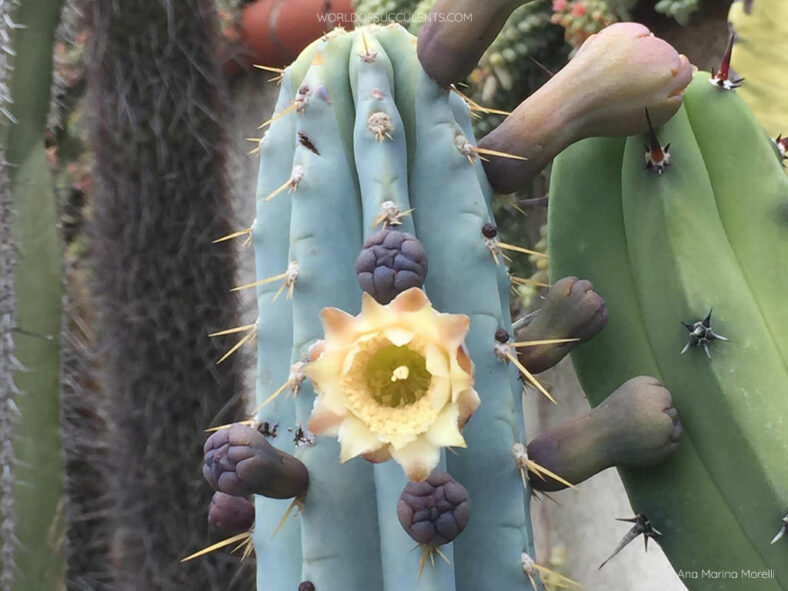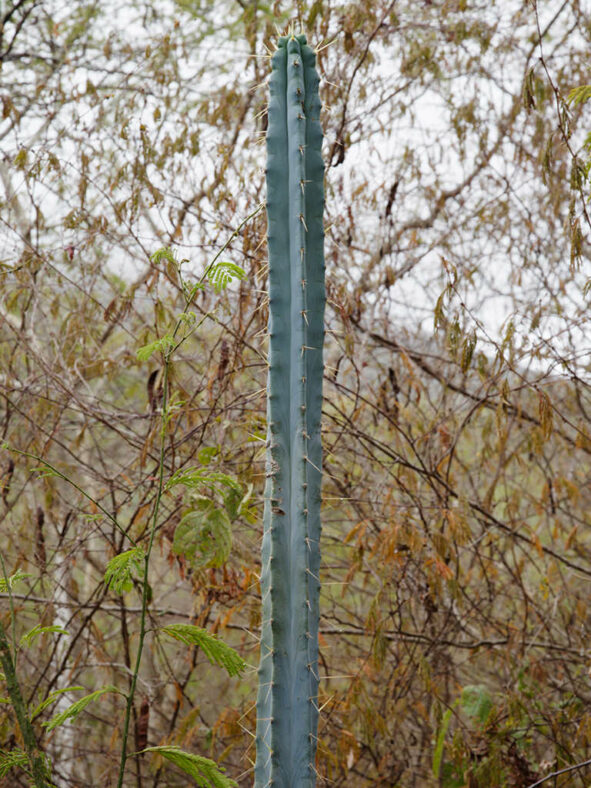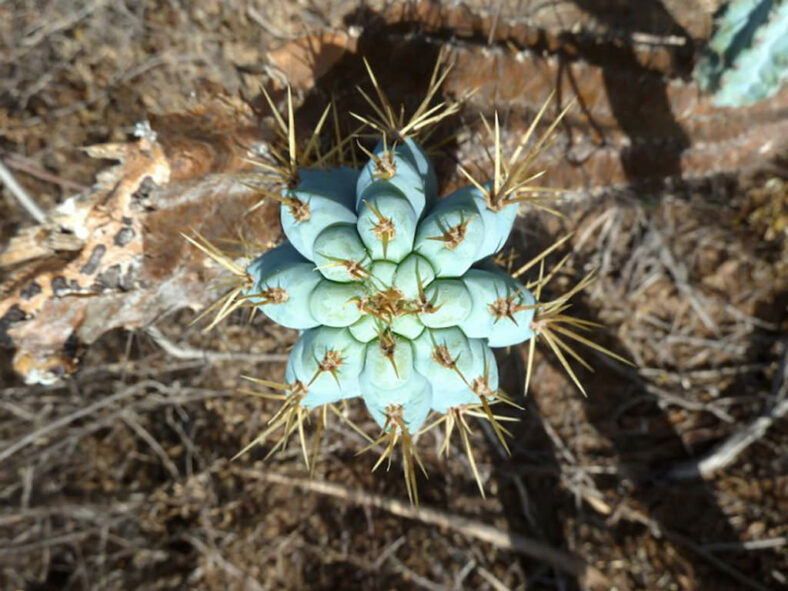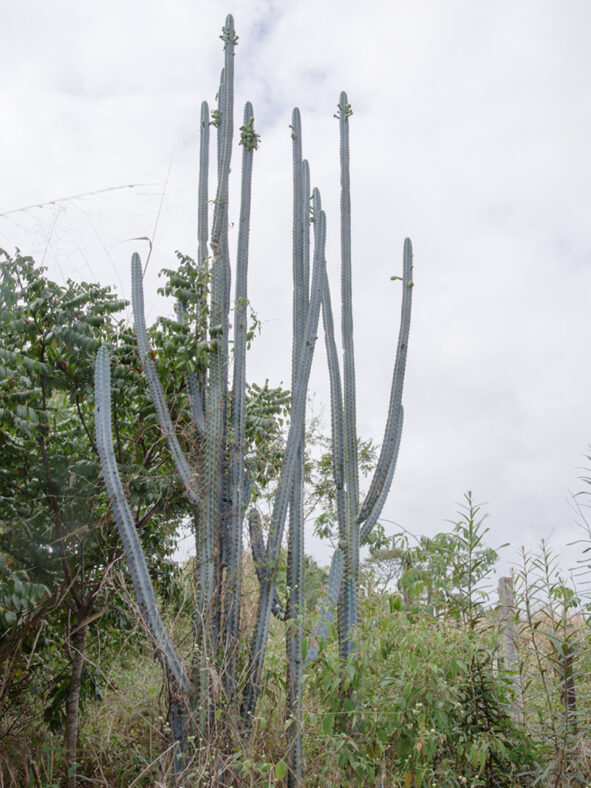Pilosocereus pentaedrophorus was first described by J. Labouret in 1853 as Cereus pentaedrophorus.
Scientific Name
Pilosocereus pentaedrophorus (Labour.) Byles & G.D.Rowley
Synonym(s)
Cephalocereus pentaedrophorus, Cereus pentaedrophorus, Pilocereus pentaedrophorus, Pilosocereus pentaedrophorus subsp. pentaedrophorus, Pseudopilocereus pentaedrophorus
Scientific Classification
Family: Cactaceae
Subfamily: Cactoideae
Tribe: Cereeae
Genus: Pilosocereus
Etymology
The specific epithet "pentaedrophorus (pronounced pent-ay-droh-FOR-us) means "bearing five geometric solids" and refers to the stems that often have five ribs.
Origin
Pilosocereus pachycladus is native to Brazil. It occurs in Minas Gerais, Bahia, Sergipe, and Pernambuco at elevations from sea level up to 3,280 feet (1,000 m).
Description
Pilosocereus pentaedrophorus is a shrubby or tree-like cactus with erect stems that usually have 4 to 6, sometimes up to 10 ribs lined with felted areoles that bear clusters of spines. It can grow up to 20 feet (6 m) tall, branching more or less near the base. The stems are blue-green with a powdery coating and can reach up to 3 inches (7.5 cm) in diameter. The translucent spines are yellowish brown and range from 0.8 to 1 inch (2 to 2.5 cm) in length. Each areole bears 3 to 12 radial and up to 3 central spines.
During the summer, Pilosocereus pentaedrophorus produces bell-shaped flowers with white inner and green to purple outer tepals. The flowers appear in the upper portions of the stems, open at night, and can measure up to 2.2 inches (5.5 cm) long and 1.1 inches (2.8 cm) in diameter. The edible fruits are spherical, depressed at the apex, and can reach up to 1.2 inches (3 cm) in diameter. They are purplish and contain purple or magenta pulp and shiny black seeds.

How to Grow and Care for Pilosocereus pentaedrophorus
Light: Although it can handle partial shade, Pilosocereus pentaedrophorus thrives in full sun. A sunny window is a good spot if grown indoors. To encourage balanced growth, rotate the pot a quarter turn every week or two. It is best to move it outdoors from spring to fall If possible.
Soil: This cactus grows best in well-draining soil. You can either use commercial soil for cacti or make your own mix.
Hardiness: During the growing season, Pilosocereus pentaedrophorus enjoys warm temperatures, while in winter, it prefers cooler temperatures. It grows best in USDA Plant Hardiness Zones 10a to 11b, with average minimum winter temperatures ranging from 30 to 50 °F (-1.1 to 10 °C).
Watering: To keep this cactus healthy, water it thoroughly, but allow the soil to dry out completely before watering again. As fall approaches, gradually reduce the watering frequency. During the winter, when it is dormant, water this cactus only enough to prevent shrinking.
Fertilizing: During its growing season, this cactus requires regular fertilizing. A balanced, water-soluble fertilizer, diluted to 1/4 strength, can be added to each watering. A 10-10-10 fertilizer is ideal. You can also use dry fertilizers instead of making a solution of water and fertilizer. However, stop fertilizing during the winter.
Repotting: While Pilosocereus pentaedrophorus is young, it is recommended to repot it each year in early spring. Once it matures, repot it when it is outgrowing its pot.
Propagation: The easiest method to propagate this cactus is by stem cuttings, as seed propagation is a slow process. Spring and summer are the best time to take cuttings and sow the seeds.
Learn more at How to Grow and Care for Cereus.
Toxicity of Pilosocereus pentaedrophorus
Pilosocereus pentaedrophorus is considered non-toxic. However, keep it away from pets and children as it has sharp spines.
Links
- Back to genus Pilosocereus
- Succupedia: Browse succulents by Scientific Name, Common Name, Genus, Family, USDA Hardiness Zone, Origin, or cacti by Genus
Photo Gallery
Click on a photo to see a larger version.


